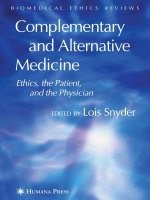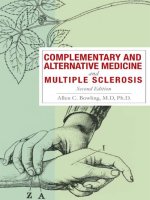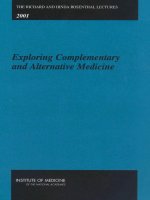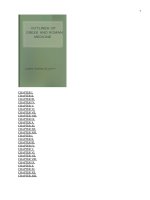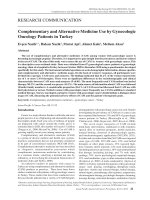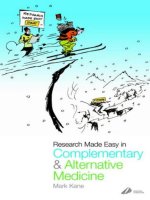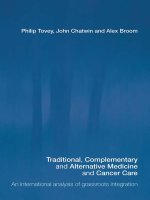Utilisation of complementary and alternative medicine (CAM) practitioners within maternity care provision: results from a nationally representative cohort study of 1,835 pregnant women docx
Bạn đang xem bản rút gọn của tài liệu. Xem và tải ngay bản đầy đủ của tài liệu tại đây (161.53 KB, 19 trang )
This Provisional PDF corresponds to the article as it appeared upon acceptance. Fully formatted
PDF and full text (HTML) versions will be made available soon.
Utilisation of complementary and alternative medicine (CAM) practitioners within
maternity care provision: results from a nationally representative cohort study of
1,835 pregnant women
BMC Pregnancy and Childbirth 2012, 12:146 doi:10.1186/1471-2393-12-146
Amie Steel ()
Jon Adams ()
David Sibbritt ()
Alex Broom ()
Cindy Gallois ()
Jane Frawley ()
ISSN 1471-2393
Article type Research article
Submission date 23 September 2012
Acceptance date 4 December 2012
Publication date 12 December 2012
Article URL />Like all articles in BMC journals, this peer-reviewed article can be downloaded, printed and
distributed freely for any purposes (see copyright notice below).
Articles in BMC journals are listed in PubMed and archived at PubMed Central.
For information about publishing your research in BMC journals or any BioMed Central journal, go to
/>BMC Pregnancy and Childbirth
© 2012 Steel et al.
This is an open access article distributed under the terms of the Creative Commons Attribution License ( />which permits unrestricted use, distribution, and reproduction in any medium, provided the original work is properly cited.
Utilisation of complementary and alternative
medicine (CAM) practitioners within maternity care
provision: results from a nationally representative
cohort study of 1,835 pregnant women
Amie Steel
1*
*
Corresponding author
Email:
Jon Adams
1
Email:
David Sibbritt
1
Email:
Alex Broom
2
Email:
Cindy Gallois
2
Email:
Jane Frawley
1
Email:
1
Faculty of Health, UTS, Level 7, Building 10, 235-253 Jones Street, Ultimo,
New South Wales 2006, Australia
2
School of Social Science, University of Queensland, St Lucia, Queensland
4072, Australia
Abstract
Background
There is little known about women’s concurrent use of conventional and complementary
health care during pregnancy, particularly consultation patterns with complementary and
alternative medicine (CAM). This study examines health service utilisation among pregnant
women including consultations with obstetricians, midwives, general practitioners (GPs) and
CAM practitioners.
Methods
A sub-study of pregnant women (n=2445) was undertaken from the nationally-representative
Australian Longitudinal Study on Women’s Health (ALSWH). Women’s consultations with
conventional practitioners (obstetricians, GPs and midwives) and CAM practitioners for
pregnancy-related health conditions were analysed. The analysis included Pearson chi-square
tests to compare categorical variables.
Results
The survey was completed by 1835 women (response rate = 79.2%). A substantial number
(49.4%) of respondents consulted with a CAM practitioner for pregnancy-related health
conditions. Many participants consulted only with a CAM practitioner for assistance with
certain conditions such as neck pain (74.6%) and sciatica (40.4%). Meanwhile, women
consulted both CAM practitioners and conventional maternity health professionals
(obstetricians, midwives and GPs) for back pain (61.8%) and gestational diabetes (22.2%).
Women visiting a general practitioner (GP) 3–4 times for pregnancy care were more likely to
consult with acupuncturists compared with those consulting a GP less often (p=<0.001,
x
2
=20.5). Women who had more frequent visits to a midwife were more likely to have
consulted with an acupuncturist (p=<0.001, x
2
=18.9) or a doula (p=<0.001, x
2
=23.2) than
those visiting midwives less frequently for their pregnancy care.
Conclusions
The results emphasise the necessity for a considered and collaborative approach to
interactions between pregnant women, conventional maternity health providers and CAM
practitioners to accommodate appropriate information transferral and co-ordinated maternity
care. The absence of sufficient clinical evidence regarding many commonly used CAM
practices during pregnancy also requires urgent attention.
Keywords
Pregnancy, Complementary medicine, Health services, Interprofessional, Integrative
medicine
Background
Women’s health and the rise of complementary and alternative medicine
Complementary and alternative medicine (CAM) - a range of treatments and practices not
traditionally associated with the conventional medical profession or medical curriculum [1] -
is more commonly used by women than men [2,3]. CAM appears to be making its presence
felt with regards to a number of women’s health issues [4-7] and, consistent with the wider
population [8,9], female CAM users employ these treatments supplementary to conventional
care [4].
Pregnancy and CAM: evidence, communication and risk
Pregnant and birthing women have been identified as substantial CAM users with prevalence
rates of between 20% to 60% [5] - a usage suggested to be in line with the search for a
‘natural’ pregnancy and birthing experience (free, where possible, from medical intervention)
[10,11]. While a small but emerging body of literature highlights acupuncture/acupressure,
aromatherapy, chiropractic, homoeopathy, massage and yoga as popular amongst pregnant
women [5,12] opinions differ on the validity and safety of these CAM practices for
pregnancy [10,13,14]. Approximately 30% of pregnant women who consult CAM therapists
do so without informing their midwife or doctor [15] yet there is also evidence of CAM
referral practices in maternity care [16]. CAM referrals during pregnancy are more likely to
be midwife-led than obstetrician-led and obstetricians appear more cautious and sceptical
than midwives about CAM use for women in their care [16].
Evidence of the efficacy of specific CAM modalities for different pregnancy-related
complaints, while emerging, remains scant [17-22]. A systematic review has identified a
trend towards improved outcomes for women receiving chiropractic care for pregnancy-
related back pain [18]. Acupuncture may be an effective approach for the management of
nausea and vomiting [20] and pelvic or back pain in pregnancy [22] and naturopathic
recommendations for the treatment of nausea in pregnancy (including ginger and vitamin B6)
[14] appear to have some low-level evidence of benefit [21].
Identifying gaps in CAM use in maternity care research
From within the small yet growing body of research focused upon CAM use for pregnancy
[2,5], the majority has examined pregnant women’s use of discrete supplements or treatments
and, despite recommendations [23,24], there has been little exploration of women’s
consultations with CAM practitioners. One exception is a recent longitudinal cohort study
(n=535) [7] which identified no significant change in this prevalence rate over a 10 year
period compared with non-pregnant women. Unfortunately, this recent work does not discern
the prevalence of pregnant women’s use of specific types of CAM practitioners or examine
the patterns of pregnant women’s consultations with CAM practitioners for the purpose of
managing pregnancy-related health concerns. Neither does this previous work examine how
such consultation patterns relate to the use of conventional maternity care providers, explore
the health reasons for which pregnant women consult CAM practitioners or draw from a
nationally representative sample of pregnant women. In response to these important
knowledge gaps, this study - presenting findings from the largest nationally representative
cohort of pregnant women on CAM use to date (n=1835) – aims to provide the first detailed
examination of conventional and CAM practitioner use during pregnancy.
Methods
This research was conducted as part of a sub-study of the Australian Longitudinal Study on
Women’s Health (ALSWH) investigating women’s use of health care during pregnancy and
birthing, conducted in 2010. The ALSWH was established in 1996, when women in three age
groups (‘younger’ 18–23, ‘mid age’ 45–50 and ‘older’ 70–75 years) were randomly selected
from the national Medicare database. The ALSWH was designed to examine demographic,
social, physical, psychological, and behavioural variables and their effect on major aspects of
women’s health and wellbeing. Women from the ALSWH younger cohort, who were aged
31–36 years in 2009 (n=8012) and who identified as being pregnant or as having recently
given birth in the 2009 ALSWH survey (n=2445) were identified for inclusion in the sub-
study and were surveyed in 2010. Ethics approval for the sub-study was gained from the
University of Newcastle ethics committee (#H-2010_0031).
Demographic characteristics
The women were asked about their marital status, educational qualifications and health
insurance cover.
Health service utilisation
Women were asked about their visits to health care practitioners including conventional
maternity care providers (general practitioners (GPs), obstetricians and midwives) and CAM
practitioners (acupuncturists, aromatherapists, chiropractors, naturopaths/herbalists, doulas,
massage therapists, meditation/yoga practitioners, osteopaths).
Reasons for use of CAM
Women were asked who they consulted for management of pregnancy-related conditions.
Women were also asked to rate their level of satisfaction with a variety of care options for
their pregnancy and birth including GPs, obstetricians and midwives.
Statistical analyses
Pearson’s chi-square tests were used to compare categorical variables. To correct for multiple
statistical testing, a modified Bonferroni correction was used [25]. All analyses were
conducted using the statistical software Stata 11.2.
Results
There were 1835 women who completed and returned the questionnaire (RR=79.2%), the
majority of which were in a relationship (96.3%) and had tertiary level education (60.1%).
The majority of women had current private health insurance (72%), with 58.4% including
cover for pregnancy-related care.
Conventional and complementary health service utilisation during pregnancy
During pregnancy and birth, the women consulted with a diverse range of both conventional
maternity care practitioners and CAM practitioners (see Table 1). Almost all women (99.8%)
had consulted with a conventional practitioner at some stage during their pregnancy with the
most common being a GP (90.6%). Meanwhile, half (49.4%) had consulted with a CAM
practitioner of some kind, most commonly with a massage therapist (34.1%), chiropractor
(16.3%) and a meditation/yoga practitioner (13.6%).
Table 1 Women’s consultations with complementary and alternative medicine (CAM) and conventional medicine practitioners for
pregnancy-related health conditions
Professional Group
None
1 or 2
3 or 4
5 or 6
7 or more
Total
Respondents
% % % % % % n
GP (n = 1734) 9.9 51 14.8 9.5 14.8 90.6 1734
Obstetrician (n=1662) 14.8 13.8 7.2 13.2 51 86.6 1662
Midwife (n=1520) 35.3 20.1 12.5 12.4 19.7 70.7 1520
Any conventional practitioner 99.8
Acupuncturist (n=1714) 90.6 4 2.4 1.3 1.7 9.5 1714
Aromatherapist (n=1670) 99.4 0.5 0 0.06 0.06 0.6 1670
Chiropractor (n=1709) 83.7 4 4.3 2.8 5.3 16.3 1709
Naturopath/Herbalist (n=1684) 92.8 4.3 1.6 0.8 0.5 7.2 1684
Doula (n=1667) 98.6 0.7 0.4 0.1 0.2 1.4 1667
Massage (n=1743) 65.9 20.6 7.3 3.2 3 34.1 1743
Meditation/Yoga (n=1690) 86.4 2.5 1.7 1.6 7.8 13.6 1690
Osteopath (n=1690) 93.9 2.5 1.2 0.9 1.5 6.2 1690
Any CAM practitioner 49.4
The women engaged with a number of practitioners concurrently (see Table 2), with a
substantial number of participants consulting with two (48.2%) or three (42.2%) types of
conventional maternity carers during their pregnancy. In contrast, the majority of women
consulting a CAM practitioner consulted with only one or, less frequently, two practitioner
types during pregnancy.
Table 2 Different conventional and CAM practitioner professional groups consulted by women for pregnancy-related health conditions
Practitioners Conventional
medicine
*
(n=1366)
Complementary
medicine
†
(n=1629)
% %
0 0.2 54
1 9.4 25.7
2 48.2 13.1
3 42.2 4.8
4 - 1.8
5 - 0.5
6 - 0.1
*
Conventional medicine practitioners includes obstetricians, midwives and general practitioners
†
Complementary medicine practitioners includes acupuncturists, aromatherapists, chiropractors, naturopaths/herbalists, doulas, massage
therapists, meditation/yoga classes, and osteopaths
The women consulted a wide range of health care professionals for a variety of conditions
and/or symptoms (see Table 3). The most prevalent condition reported was back pain
(39.5%), for which the women most commonly consulted with chiropractors (11.3%)
followed by obstetricians (5.9%) and GPs (4.3%). Meanwhile, those women reporting
tiredness (35.4%) predominantly consulted with their obstetrician (6.2%) and GP (4.7%).
Other than for back pain (4.1%), women mostly consulted with acupuncturists to help prepare
for labour (2.4%) and with naturopaths for nausea (1.6%). In contrast, massage therapists
were rarely consulted for back pain (0.5%) but were seen for sciatica (6.6%), neck pain
(5.9%) and hip pain (4.5%).
Table 3 Patterns of consultations with conventional and CAM practitioners for pregnancy-related conditions (n=1835)
Condition
All women
Conventional practitioners
CAM practitioners
General practitioner
Obstetrician
Midwife
Chiropractor
Acupuncturist
Naturopath
Massage
% % % % % % % %
Back pain 39.5
4.3 5.9 4.1 11.3 4.1 1.7 0.5
Tiredness 35.4
4.7 6.2 3.7 0.4 1.0 1.2 1.0
Reflux/Indigestion 34.7
8.6 12.4 5.0 0.2 0.3 1.0 0.1
Nausea 32.9
12.7 10.5 3.9 0.4 1.3 1.6 0.2
Sciatica 22.1
4.6 5.1 2.9 5.3 1.3 0.2 6.6
Preparing for labour 21.9
3.7 11.9 16.2 1.0 2.4 0.9 0.9
Hip pain 20.9
3.8 5.9 4.4 5.0 1.1 0.1 4.5
Leg cramps 18.2
3.2 4.5 2.9 0.3 0.2 0.6 0.9
Constipation 16.7
4.6 4.9 2.9 0.1 0.5 0.5 0.1
Headache 16.0
5.2 3.7 1.9 2.9 0.4 0.2 1.9
Haemorrhoids 15.8
5.7 4.1 2.1 0.0 0.1 0.4 0.0
Sleeping problems 15.2
2.6 2.8 1.7 0.3 0.5 0.7 0.3
Neck pain 12.4
0.7 0.9 0.7 5.7 0.4 0.2 5.9
Repeated Vomiting 11.0
6.7 5.1 2.0 0.2 0.5 0.4 0.1
Vaginal bleeding 10.4
6.2 7.0 1.7 0.1 0.1 0.1 0.0
Varicose veins 9.4 2.9 3.6 2.5 0.2 0.1 0.2 0.1
Fluid retention 8.7 1.8 3.3 2.0 0.1 0.5 0.3 0.4
Anaemia 7.4 3.8 4.5 2.0 0.0 0.0 0.3 0.3
High Blood Pressure 6.6 3.3 5.3 2.3 0.1 0.2 0.0 0.0
Cravings 6.3 0.4 0.2 0.5 0.1 0.0 0.3 0.0
Dizziness or fainting 6.3 2.9 2.5 1.1 0.1 0.1 0.1 0.1
Weight management 5.5 2.0 1.7 0.6 0.1 0.1 0.2 0.0
Gestational diabetes 4.9 1.7 3.7 1.5 0.0 0.1 0.1 0.0
Urinary Tract Infection 4.9 3.7 1.3 0.5 0.0 0.1 0.0 0.0
Pre-eclampsia 3.2 1.3 3.3 1.6 0.1 0.1 0.2 0.0
Table 4 reports the patterns of women with pregnancy-related health condition consulting
with any practitioner from a conventional maternity or CAM professional group, or a
combination of practitioners from each group. Amongst the women who reported a
pregnancy-related health conditions, many only consulted with a CAM practitioner - 74.6%
of women with neck pain, 40.4% of women with sciatica and 35.4% of women with hip pain.
Those with back pain were more likely to consult with both conventional and CAM
practitioners (61.8%). The majority of women did not seek support from any health
professionals for common discomforts such as cravings (81.9%) and tiredness (65.6%).
Midwives, GPs and obstetricians were consulted without the inclusion of CAM practitioners
for vaginal bleeding (95.8%), high blood pressure (93.4%), pre-eclampsia (93.1%), anaemia
(84.6%) and urinary tract infections (83.3%). Gestational diabetes was also associated with
the use of conventional practitioners (64.4%) but a significant number of women (22.2%)
consulted with both conventional and CAM practitioners for this condition. Pre-eclampsia
was the only condition for which no women consulted with CAM practitioners in isolation.
Table 4 Patterns of consultations with conventional and CAM practitioners by women with pregnancy-related health conditions
Condition
Only women with
pregnancy
-
related condition
Sought no support
*
CAM practitioner only
†
Both CAM and conventional practitioners
Conventional practitioner only
§
% % % %
Back pain (n=725) 3.9 2.2 61.8 32.1
Tiredness (n=649) 65.6 6.0 2.3 26.0
Reflux/Indigestion (n=637) 40.8 6.0 1.9 51.3
Nausea (n=604) 42.2 5.0 4.6 48.2
Sciatica (n=406) 20.7 40.4 16.3 22.7
Preparing for labour (n=401) 3.2 11.0 13.7 72.1
Hip pain (n=304) 21.9 35.4 17.5 25.3
Leg cramps (n=334) 53.3 7.8 2.1 36.8
Constipation (n=307) 41.4 6.5 1.3 50.8
Headache (n=293) 33.1 21.8 7.9 37.2
Haemorrhoids (n=289) 36.7 4.5 1.4 57.4
Sleeping problems (n=279) 57.4 7.9 4.7 30.1
Neck pain (n=228) 14.9 74.6 5.3 5.3
Repeated Vomiting (n=201) 42.2 5.0 4.6 48.2
Vaginal bleeding (n=191) 2.1 0.5 1.6 95.8
Varicose veins (n=172) 28.5 2.3 3.5 65.7
Fluid retention (n=160) 41.9 5.0 5.0 48.1
Anaemia (n=136) 11.0 0.7 3.7 84.6
High Blood Pressure (n=121) 5.8 0.8 0.0 93.4
Cravings (n=116) 81.9 3.5 0.9 13.8
Dizziness or fainting (n=115) 34.8 3.5 1.7 60.0
Weight management (n=102) 36.3 4.9 5.9 52.9
Gestational diabetes (n=90) 6.7 6.7 22.2 64.4
Urinary Tract Infection (n=90) 13.3 1.1 2.2 83.3
Pre-eclampsia (n=58) 1.7 0.0 5.2 93.1
*
Women who did not report seeking support from a health professional for the designated pregnancy-related condition
†
Women who only consulted with a CAM practitioner for the designated pregnancy-related condition. This includes chiropractors,
acupuncturists, naturopaths and massage therapists
‡
Women who consulted with both a conventional and CAM practitioner for the designated pregnancy-related condition
§
Women who only consulted with a conventional practitioner for the designated pregnancy-related condition
Factors associated with women’s use of CAM during pregnancy
Women consulting CAM practitioners had different consultation patterns with specific
conventional practitioners (Table 5). Women who consulted an acupuncturist (p<0.001)
during pregnancy visited a GP less frequently than women not consulting an acupuncturist.
Women using the services of a doula consulted an obstetrician less frequently than those
women who did not use a doula (p<0.001). In contrast, women who had more frequent visits
with a midwife were more likely to consult an acupuncturist (p<0.001) or doula (p<0.001).
Women’s levels of satisfaction with the care provided by their conventional maternity
providers had little impact on their consultation patterns with CAM practitioners during
pregnancy (data not shown).
Table 5 The relationship between consultations with CAM practitioners and the number of visits with conventional maternity carers
(n=1835)
Practitioner
Visits with General Practitioner
Visits with Obstetrician
Visits with Midwife
None
1 or 2
3 or 4
5+
P value
χ
2
None
1 or 2
3 or 4
5+
P value
χ
2
None
1 or 2
3 or 4
5+
P value
χ
2
Acupuncturist
No (%)
93.4 91 83.3 93.4
<0.001
a
20.6
87.3 89.7 92.0 91.4
0.23 4.3 93.3 94.2 89.8 88.8
<0.001
c
18.9
Yes (%)
6.6 9 16.7 6.6 12.7 10.3 8.0 8.6 6.7 5.8 10.2 13.6
Aromatherapist
No (%)
99.4 99.5 99.4 99.2
0.89 0.6 99.6 99.5 100.0 99.3
0.78 1.1 99.6 99 99.4 99.6
0.66 1.6
Yes (%)
0.6 0.5 0.9 0.8 0.4 0.5 0.0 0.7 0.4 1 0.6 0.4
Chiropractor
No (%)
85.5 84.9 83.1 80.7
0.29 3.8 79.7 81.8 80.2 85.2
0.11 6.0 86.4 80.8 84.5 93.3
0.2 4.6
Yes (%)
14.6 15.2 17 19.3
20.3 18.2 19.8 14.8
13.6 19.2 15.5 16.7
Naturopath
No (%)
96.3 92.4 89.7 94.1
0.05 7.7 92.1 91.2 95.5 93.1
0.51 2.3 93.3 94.1 94.7 90.0
0.08 6.8
Yes (%)
3.7 7.6 10.3 5.9 7.9 8.8 4.6 6.9 6.7 5.9 5.3 10.0
Doula
No (%)
99.4 98.8 97.8 98.7
0.57 2.0 95.8 96.7 100 99.6
<0.001
b
27.8
99.8 100 97.6 96.6
<0.001
c
23.2
Yes (%)
0.6 1.2 2.2 1.3 4.2 3.3 0 0.4 0.2 0 2.4 3.4
Massage therapist
No (%)
66.7 65.1 62.6 70.5
0.16 5.1 70.3 66.2 64.4 64.1
0.34 3.3 93.3 94.2 89.8 65.2
0.85 0.8
Yes (%)
33.3 34.9 37.4 29.5
29.8 33.8 35.7 35.9
6.7 5.8 10.2 34.8
Meditation/yoga
No (%)
87.9 85.6 83.3 88.8
0.21 4.5 84.3 85.9 89.2 86.4
0.66 1.6 99.6 99.0 99.4 83.9
0.19 4.8
Yes (%)
12.1 14.4 16.7 11.2
15.7 14.2 10.8 13.6
0.4 1.1 0.6 16.1
Osteopath
No (%)
95.2 93.6 89.8 96.4
0.009 11.6
94.2 96.3 92.0 93.4
0.35 3.3 86.4 80.8 84.5 93.8
0.87 0.7
Yes (%)
4.8 6.4 10.2 3.6 5.8 3.7 8.0 6.6 13.6 19.2 15.5 6.2
a
statistically significant association with general practitioner consultations for pregnancy-related health conditions (p<0.005)
b
statistically significant association with obstetrician consultation for pregnancy-related health conditions (p<0.005)
c
statistically significant association with midwife consultation for pregnancy-related health conditions (p<0.005)
Discussion
This study of a large, nationally representative sample of Australian women who had recently
given birth provides the first examination of consultancy patterns across conventional
maternity care providers and CAM practitioners during pregnancy. The study presents four
key findings. First, the study reveals a substantial level of CAM practitioner use with nearly
half of the pregnant women consulting a CAM practitioner concurrent to conventional
maternity care. This finding highlights the supplementary nature of CAM use during
pregnancy, in line with results from previous studies of CAM consumption both specific to
women [4] and in the wider population [8,9].
Second, within the wider pattern of concurrent care, we identified a more complex
relationship between the two broader provider groups – for high users of GPs, consultation
with some CAM practitioners (eg. acupuncturists) is associated with less frequent visits with
a GP. It is possible that this finding reflects a change in women’s health-seeking behaviour as
a result of what they perceive as a discouraging response by their GPs to their concerns or
preferences [26,27]. It may also highlight a discord between what pregnant women seek [5]
and what some GPs may consider unhelpful or irrelevant [28,29]. Alternatively, this finding
may be due to a perception amongst these pregnant women that GPs are not core to their
maternity care needs (instead addressing such needs with CAM practitioner services),
although earlier work suggests that such a view is unlikely to be encouraged by the majority
of CAM providers [30].
Third, the findings reveal that frequent midwifery care users are more likely to consult
acupuncturists and doulas. This finding supports previous research identifying midwives as a
popular source of CAM information for pregnant women [5] and often encouraging CAM use
for women in their care [31]. Alternatively, this finding could suggest that women choosing
different models of maternity care also hold different values and approaches to CAM use, an
issue identified in more general CAM utilisation research [2] but still requiring further
investigation in relation to maternity care [32]. Previous research identifies midwives as
referring to a range of CAM practitioners - naturopaths/herbalists, homeopaths, chiropractors,
osteopaths and massage therapists [16]. The difference between these results and our study
findings may be due to the various political and cultural contexts affecting CAM (e.g.
political legitimacy) and midwifery (e.g. structure of maternity care provision) across
different health systems.
Fourth, our analysis of consultation patterns for the management of specific pregnancy-
related conditions suggests pregnant women are making discretionary decisions regarding
whom to consult depending on their immediate health concerns. Chiropractors are frequently
consulted for back pain and sciatica, massage therapists consulted more commonly for neck
pain, and naturopaths and acupuncturists more likely to be consulted for pregnancy-related
nausea. Women are consulting with CAM practitioners most commonly for management of
pain-related conditions. This may be due to women’s perceptions of CAM treatments as safer
(while being equally effective) than conventional pain management [5]. However, this
perception is only held when the condition is self-assessed by the women as low risk to them
or their babies and women are only rarely consulting with CAM practitioners for more
serious complications. Attempts to complement conventional treatments with the care of
other therapists still occur - we identified a substantial rate of concurrent CAM and
conventional practitioner use amongst pregnant women with gestational diabetes - and this
may be the result of women seeking an improved prognosis for these serious conditions
and/or a more active role in maintaining their health [5].
Our results highlight a substantial level of CAM practitioner use during pregnancy and a
pattern of selective use across different CAM practitioner groups for different health
conditions. Our study findings illustrate the inconsistent relationship between the available
clinical evidence and the CAM practitioners used by pregnant women. Whilst there is partial
alignment between some of the CAM practitioners consulted and the limited existing clinical
evidence there are also a number of women consulting CAM practitioners for specific
conditions despite an absence of clinical evidence. This underlines concerns that women may
be accessing unsafe and ineffective practices. In order to help inform safe, effective and
coordinated maternity care that reflects the full breadth of practitioner consultations amongst
pregnant women, future research must include examination of decision-making and
communication between pregnant women and their maternity care providers about CAM
practitioner use. The absence of sufficient clinical evidence regarding many commonly used
CAM practices during pregnancy also requires urgent attention.
The main strengths of this study are the high response rate, sample size and national
representative sample of pregnant women [5]. This is also the first study to provide insights
into the relationship between women’s consultation practices with CAM and conventional
care providers for pregnancy-related health conditions. The interpretation of our findings is
potentially limited by the fact that health care utilisation is self-reported by the participants
and as such our results may be open to the effects of recall bias. In addition, the medical
conditions and symptoms were defined by self-report and the lack of confirmatory diagnosis
could potentially bias findings. Previous research in this area has identified recall bias is more
likely to have affected participants self-report of health conditions related to maternal health
during pregnancy such as nausea and vaginal bleeding [33] whilst other more general aspects
of health and care provision are less affected [34]. Despite this the ALSWH is a respected
source of data for epidemiological research relating to women’s health in Australia, and these
limitations are far outstripped by the opportunities provided from conducting the first analysis
of CAM and conventional practitioner use amongst a large, nationally representative sample
of pregnant women.
Conclusions
The results from our study have implications for patient safety, access and coordination of
maternity care. The study identifies possible barriers to the disclosure and regular
communication of CAM use to key members of women’s wider maternity care team posing a
potential challenge to effective, inter-professional maternity care across the
conventional/CAM practitioner divide [35]. There is a pressing need to facilitate open
discussion and disclosure regarding CAM practitioner and CAM use between pregnant
women and their maternity care providers.
The research on which this paper is based was conducted as part of the Australian
Longitudinal Study on Women’s Health. We are grateful to the Australian Government
Department of Health and Ageing (DOHA) and the Australian Research Council
(DP1094765) for funding and to the women who provided the survey data.
Competing interests
We declare that no authors have real or potential conflicts of interest related to this study.
Authors’ contributions
All the authors contributed to the drafting and revision of the article for important intellectual
content, and approved the final version to be published. AS had full access to all the data in
the study and is the study guarantor. JA, DS, AB, and CG were responsible for the study
concept and design. AS and DS were responsible for the data analysis. All the authors
participated in the interpretation of data.
Details of ethics approval
This project has obtained ethical approval from the University of Newcastle (#H-2010_0031),
University of Queensland (#2010000411) and the University of Technology Sydney (#2011-
174N), and all participants gave informed consent before taking part.
Funding
This research was funded via an Australian Research Council Discovery Project grant
(DP1094765).
References
1. Zollmann C, Vickers A: What is complementary medicine? Br Med J 1999, 319:693.
2. Adams J, Sibbritt D, Easthope G: Examining the relationship between women’s health
and the use of complementary and alternative medicine (CAM). Complement Ther Med
2003, 11(3):156–158.
3. Andrews G, Adams J, Segrott J: Alternative medicine in the concept of care. In The
Companion to Health and Medical Geography. Edited by Brown T, McLafferty S, Moon G.
London: Blackwell; 2009.
4. Adams J, Sibbritt D, Easthope G, Young A: The profile of women who consult
alternative health practitioners in Australia. Med J Aust 2003, 179:297–300.
5. Adams J, Lui C-W, Sibbritt D, Broom A, Wardle J, Homer C, Beck S: Women’s use of
complementary and alternative medicine during pregnancy: a critical review of the
literature. Birth 2009, 36(3):237–245.
6. Lantz PM, Low LK, Varkey S, Watson RL: Doulas as childbirth paraprofessionals:
results from a national survey. Womens Health Issues 2005, 15(3):109–116.
7. Adams J, Sibbritt D, Lui C-W: The use of complementary and alternative medicine
during pregnancy: a longitudinal study of australian women. Birth 2011, 38(3):200–206.
8. Steinsbekk A, Adams J, Sibbritt D, Jacobsen G, Johnsen R: The profile of adults who
consult alternative health practitioners and/or general practitioners. Scand J Prim
Health Care 2007, 25(2):86–92.
9. Pledger MJ, Cumming J, Burnette M: Health service use amongst users of
complementary and alternative medicine. In N Z Med J. vol. 123.; 2010.
10. Tiran D: Viewpoint - midwives’ enthusiasm for complementary therapies: a cause
for concern? Complement Ther Nurs Midwifery 2004, 10:77–79.
11. Tovey P, Adams J: Nostalgic and nostophobic referencing and the authentication of
nurses’ use of complementary therapies. Soc Sci Med 2003, 56:1466–1480.
12. Bishop FL, Northstone K, Green JR, Thompson EA: The use of complementary and
alternative medicine in pregnancy: data from the avon longitudinal study of parents
and children. Complement Ther Med 2011, 19:303–310.
13. Tiran D: Complementary therapies in pregnancy: midwives’ and obstetricians’
appreciation of risk. Complement Ther Clin Pract 2006, 12:126–131.
14. Wardle J, Steel A: Fertility, preconception care and pregnancy. In Clinical
naturopathy: an evidence-based guide to practice. Edited by Sarris J, Wardle J. Chatswood:
Elsevier; 2010:622–652.
15. Eisenberg D, Kessler R, Rompay M, Kaptchuk T, Wilkey S, Appel S, Davis R:
Perceptions about complementary therapies relative to conventional therapies among
adults who use both: results from a national survey. Ann Intern Med 2001, 135(5):344–
351.
16. Adams J, Lui C-W, Sibbritt D, Broom A, Wardle J, Homer C: Attitudes and referral
practices of maternity care professionals with regard to complementary and alternative
medicine: an integrative review. J Adv Nursing 2011, In Press.
17. Ernst E, Watson L: Midwives’ use of complementary/alternative treatments.
Midwifery 2011,
18. Stuber KJ, Smith DL: Chiropractic treatment of pregnancy-related low back pain: a
systematic review of the evidence. J Manipulative Physiol Ther 2008, 31:447–454.
19. Santilli V, Beghi E, Finucci S: Chiropractic manipulation in the treatment of acute
back pain and sciatica with disc protrusion: a randomized double-blind clinical trial of
active and simulated spinal manipulations. Spine J 2006, 6(2):131–137.
20. Helmreich RJ, Shiao S-YPK, Dune LS: Meta-analysis of acustimulation effects on
nausea and vomiting in pregnant women. Explore (NY) 2006, 2(5):412–421.
21. Ensiyeh J, Sakineh M-AC: Comparing ginger and vitamin B6 for the treatment of
nausea and vomiting in pregnancy: a randomised controlled trial. Midwifery 2009,
25(3):649–653.
22. Ee CC, Manheimer E, Pirotta M, White A: Acupuncture for pelvic and back pain in
pregnancy: a systematic review. Am J Obstet Gynecol 2008, 198(3):254–259.
23. Steel A, Adams J: The role of naturopathy in pregancy, labour and postnatal care:
broadening the evidence base. Complement Ther Clin Pract 2011, 17:189–192.
24. Adams J: Growing popularity of complementary and alternative medicine during
pregnancy and implications for healthcare providers. Expert Rev Obstet Gynecol 2011,
6(4):365–366.
25. Keppel G: Design and Analysis: A Researcher’s Handbook. Englewood Cliffs: Prentice
Hall; 1991.
26. Adams J: General practitioners, complementary therapies and evidence-based
medicine: the defence of clinical autonomy. Complement Ther Med 2000, 8:248–252.
27. Maha N, Shaw A: Academic doctors’ views of complementary and alternative
medicine and its role within the NHS: an exploratory qualitative study. In BMC
Complement Altern Med. vol. 7.; 2007.
28. Poynton L, Dowell A, Dew K, Egan T: General practitioners’ attitudes toward (and
use of) complementary and alternative medicine: a New Zealand nationwide survey. N Z
Med J 2011, 119(1247):35–44.
29. Joos S, Musselmann B, Szecsney J: Integration of complementary and alternative
medicine into family practices in germany: results of a national survey. Evid Based
Complement Alternat Med 2011, 2011:1–8.
30. Ben-Arye E, Scharf M, Frenkel M: How should complementary practitioners and
physicians communicate? a cross-sectional study from israel. J Am Board Fam Med 2007,
20(6):565–571.
31. Adams J: An exploratory study of complementary and alternative medicine in
hospital midwifery: Models of care and professional struggle. Complement Ther Clin
Pract 2006, 12(1):40–47.
32. Honda K, Jacobson J: Use of complementary and alternative medicine among United
States adults: the influences of personality, coping strategies, and social support. Prevent
Med 2005, 40:46–53.
33. Bryant HE, Visser N, Love EJ: Records, recall loss, and recall bias in pregnancy: a
comparison of interview and medical records data of pregnant and postnatal women.
Am J Public Health 1989, 79(1):78–80.
34. Tomeo CA, Rich-Edwards JW, Michels KB, Berkey CS, Hunter DJ, Frazier AL, Willett
WC, Buka SL: Reproducibility and validity of maternal recall of pregnancy-related
events. Epidemiol 1999, 10(6):774–777.
35. Adams J, Tovey P (Eds): Complementary and Alternative Medicine in Nursing and
Midwifery: Towards a Critical Social Science. London: Routledge; 2008.
